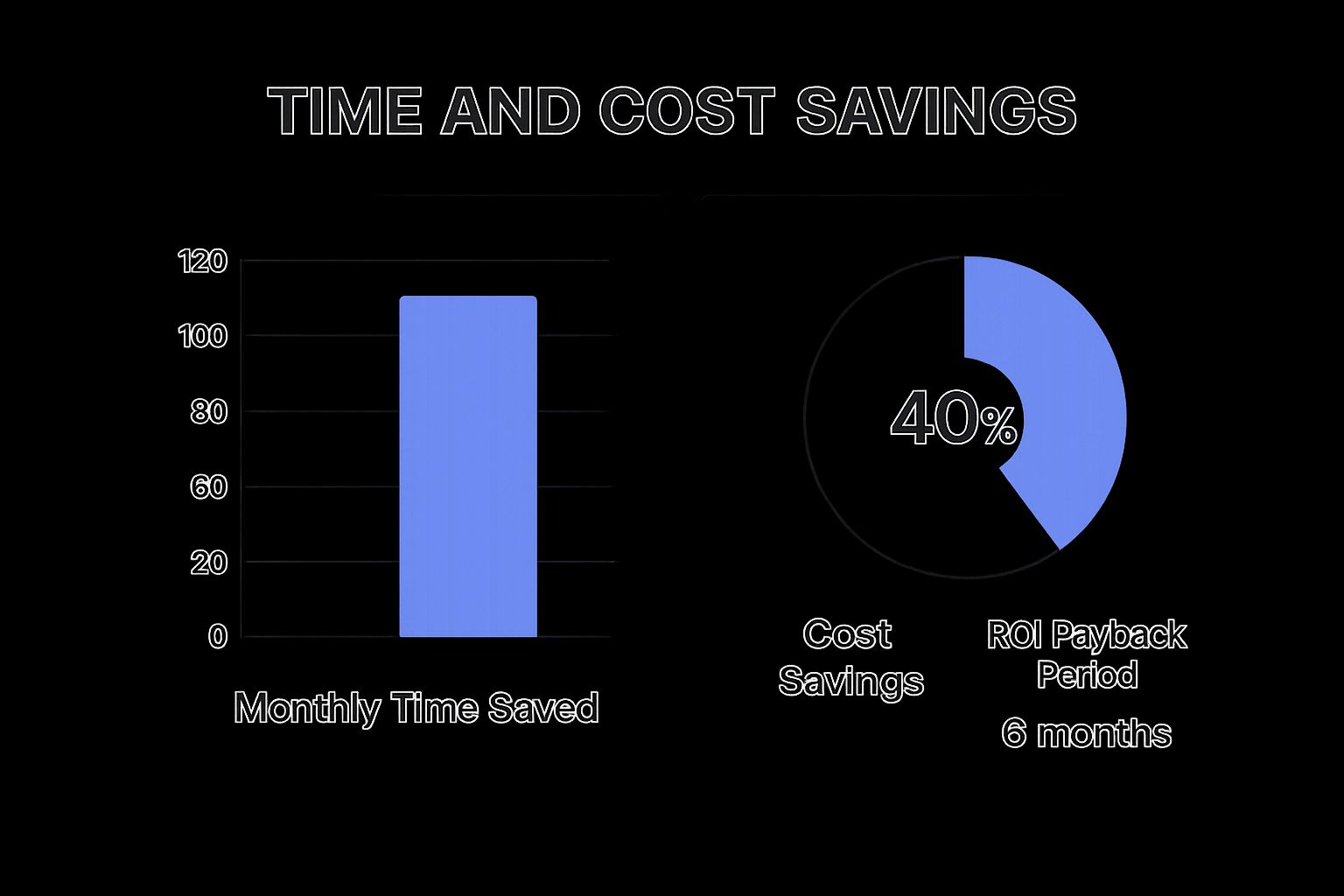That little repetitive task your team does every day? It costs a lot more than you think. The real price of keeping work manual isn't just the hours on the clock; it's a cascade of hidden costs that drain your resources, kill morale, and choke your company's potential for growth.
The Real Cost of Keeping Things Manual
Every business has them. Those "quick," routine tasks that have just always been done a certain way. Think about processing invoices, onboarding a new hire, or pulling together that weekly report. On their own, they seem minor. But add them all up, and these manual processes create a powerful undercurrent of friction that slows your entire operation to a crawl.
They are the invisible anchors holding your business back.
Let's follow a single supplier invoice to see what this really looks like. It lands in an inbox, where it sits waiting to be opened. Someone has to manually key in every last detail—vendor name, invoice number, amount, date—into your accounting software. One tiny typo, and you've either delayed payment or overpaid, kicking off hours of frustrating emails and phone calls to fix it.
The Snowball Effect of Manual Work
But it doesn't stop there. That single task sets off a chain reaction of delays. The invoice needs approval, which usually means printing it out and walking it over to a manager's desk or burying it in their email. If that manager is swamped or out of the office, everything grinds to a halt.
That one bottleneck can damage your relationship with a good vendor or even stick you with late payment fees.
This manual friction isn't just a financial headache; it hits your team directly. When skilled employees spend their days on mind-numbing, low-value work, they aren't focused on the strategic projects that actually move the needle. This is a fast track to disengagement and burnout, making it that much harder to keep your best people.
The hidden costs are literally everywhere:
- Lost Productivity: Every minute spent on data entry is a minute not spent on innovation or talking to customers.
- Sky-High Error Rates: To err is human, which means manual processes are inherently prone to mistakes that create financial and compliance risks.
- Employee Burnout: Nothing drains motivation faster than monotony. Repetitive work makes it incredibly difficult to retain your most valuable talent.
By sticking with manual processes, you're not just tolerating inefficiency—you're actively putting a cap on your own growth. Once you see these hidden drains for what they are, it becomes clear that business process automation isn't just a tech upgrade. It's a strategic necessity for survival and scale.
How Automation Creates Hyper-Efficient Operations

Think of your business operations like a road system. Manual processes are the slow, winding country roads full of stop signs, unexpected detours, and frustrating traffic jams. Business process automation (BPA) rips out that old infrastructure and lays down a direct superhighway. Information and tasks can finally move at top speed without a single interruption.
This massive leap in operational efficiency is one of the first and most powerful benefits you'll see. Automation takes over the repetitive, rule-based tasks that eat up your team's time and energy. It works 24/7 without getting tired, second-guessing itself, or needing a coffee break, making sure your most critical functions are always running.
The Customer Order Superhighway
Let’s look at a new customer order. The old way involves a clunky chain of human handoffs, where every step is a potential point of failure or delay.
- Someone has to manually type order details from an email into the CRM.
- They then have to check inventory levels in a totally different spreadsheet or system.
- Another person generates an invoice and sends it off for approval.
- Finally, someone remembers to notify the warehouse and update the customer.
This whole sequence is slow, fragile, and just begging for mistakes.
Now, imagine the automated workflow: the second an order hits your inbox, the system instantly validates the data, checks inventory in real-time, creates and sends the invoice, updates the CRM, pings the warehouse, and shoots a confirmation email to the customer. All of it happens in seconds.
By standardizing these rule-based decisions, automation removes guesswork and hesitation. Every process is executed the exact same way every single time, leading to consistent, predictable, and highly efficient outcomes.
Unleashing Your Team for High-Value Work
This newfound efficiency completely changes what your team works on. Research shows that automation already drives around 34% of business tasks around the world. Better yet, about 30% of IT professionals say employees save a huge amount of time with these tools.
They can finally shift away from tedious data entry and focus on strategic work that actually grows the business. Instead of just processing orders, your team can now analyze sales trends, find ways to improve the customer experience, or even help develop new products.
Automation doesn't just make you faster; it creates the capacity for real innovation. For instance, you could use it to pull key insights from different online sources and apply them to your strategy. We actually have a guide on how to turn websites into LLM-ready data that shows this in action. This is where the true power of hyper-efficient operations really shines.
Finding Real Savings and Boosting Your Bottom Line
When people talk about the benefits of business process automation, cost reduction is usually the first thing that comes to mind. But the real financial upside goes way deeper than just trimming the payroll. Sure, automation cuts down on direct labor costs by taking over repetitive manual tasks, but its true power is in plugging the hidden leaks that quietly drain a company's finances.
Think about the domino effect of a single, simple data entry mistake. It can trigger hours of expensive rework, frustrate a valuable client, or even lead to hefty fines for compliance slip-ups. Each of these outcomes has a real price tag. Automation pulls human error out of the equation for those tasks, protecting your bottom line from these costly—and entirely preventable—blunders.
Shifting Resources to Revenue Generation
Beyond just stopping the financial bleeding, automation actively creates new avenues for growth. When your sharpest minds are freed from the drudgery of administrative work, they can pour their energy and expertise into strategic, high-value projects. Instead of shuffling digital paperwork, they can focus on what they do best: growing the business.
This strategic pivot can look like:
- Deeper Customer Relationships: Giving your team more time to build loyalty and uncover upsell opportunities.
- Innovation and Development: Freeing up brainpower to create new products or services that capture fresh market share.
- Smarter Growth Strategies: Allowing more time for analyzing data to fine-tune sales and marketing efforts for better results.
Suddenly, a part of your business that was once a pure cost center—manual labor—transforms into a powerful engine for generating revenue. That’s a fundamental shift in your financial trajectory.
The Clear Return on Investment
This isn't just theory; the financial benefits are measurable, and they often show up fast. A quick glance at the numbers shows just how dramatic the time and cost savings can be when you automate even a common business process.

As you can see, the hours saved translate directly into major cost reductions, allowing a business to see a positive return on its investment in just a few months. It's this rapid payback that makes automation such a compelling financial move. In fact, it’s not uncommon to see a first-year return on investment (ROI) land somewhere between 30% and 200%. Over the long haul, those numbers can climb even higher.
Let's look at a concrete example to really drive this home.
ROI Comparison: Manual vs. Automated Invoice Processing
Here’s a quick cost-benefit breakdown for a small business that processes around 500 invoices a month. We'll compare the old-school manual way with a new automated system.
| Metric | Manual Process (Monthly) | Automated Process (Monthly) | Annual Savings with Automation |
|---|---|---|---|
| Labor Hours | 100 hours (@ $20/hr) | 10 hours (@ $20/hr) | - |
| Labor Cost | $2,000 | $200 | $21,600 |
| Error Rate Cost (5%) | $500 (rework, delays) | $50 (rework, delays) | $5,400 |
| Software/Tool Cost | $0 | $150 | -$1,800 |
| Total Monthly Cost | $2,500 | $400 | $25,200 |
The table makes it crystal clear. Even after accounting for the cost of the new automation software, the business saves over $25,000 a year. That's money that can be reinvested into marketing, hiring, or product development.
The key takeaway is simple: automation stops your business from leaking money through inefficiency and errors while simultaneously creating the capacity to earn more.
By investing in the right tools, you build a more resilient and profitable operation from the ground up. If you're wondering what this might look like for your own budget, it's worth exploring the costs. Many modern platforms offer scalable options, and you can easily check out different automation pricing models to see just how accessible these powerful tools have become.
Nail Your Accuracy and Make Compliance Bulletproof

In some industries, there's just no room for error. Think about finance or healthcare—a single misplaced decimal, a forgotten signature, or one missed compliance check can spiral into disaster. We're talking massive fines, legal battles, and a reputation that's suddenly in tatters.
This is where automation shifts from a "nice-to-have" to an absolute necessity. It directly tackles one of the biggest liabilities in any manual workflow: human error.
People get tired. We get distracted. We have off days. It happens. An automated system, on the other hand, doesn't. It executes every single task with the exact same precision, time after time. It never cuts corners or deviates from the rules you've set.
Build an Unbreakable Audit Trail
Let’s get specific. Imagine the tightrope walk of handling patient data in a hospital. Staff have to juggle a long list of HIPAA regulations, from verifying a patient’s identity to ensuring every piece of data is encrypted and secure. One slip-up, and you’ve got a serious data breach on your hands.
Now, let's see how an automated workflow changes the game. It turns that stressful, manual process into a secure and predictable operation. The system can:
- Instantly verify credentials against a secure database before anyone touches a sensitive file.
- Automatically log every single action. Who accessed what, when they did it, and why—creating a perfect, unchangeable audit trail.
- Flag any unusual activity in real-time, pinging a compliance officer before a small issue becomes a full-blown crisis.
Suddenly, you have a bulletproof system of record. Instead of scrambling through manual logs during an audit and just hoping everything is in order, you can present a detailed, timestamped history that proves you've met every standard.
Automation transforms compliance from a stressful, manual checklist into a reliable, background process. It acts as your ultimate safeguard, protecting your business from risk while ensuring the highest standards of quality and integrity.
By taking human error out of the equation, automation ensures your operations aren't just faster—they're fundamentally more reliable. This gives your team the confidence to focus on their actual jobs, knowing a rock-solid system is meticulously managing your compliance obligations behind the scenes.
Building a Business That Scales Effortlessly

Here’s a tough question: could your current operations handle ten times the customers tomorrow? For most businesses still tangled up in manual systems, the honest answer is a hard no. Growth feels like a constant battle against bottlenecks because every new order adds a proportional amount of work for your team.
This is where automation completely changes the game. It’s one of the most powerful benefits of business process automation—it fundamentally rewires your company's capacity for growth.
Think of the difference between a local artisan bakery and a modern food production factory. The bakery relies on skilled bakers putting in longer hours to make more bread. Eventually, they hit a wall. There’s a physical limit to what they can produce.
The factory, on the other hand, runs on automated systems. To ramp up production, they just run the machines longer or faster. It can handle a massive spike in orders without having to proportionally increase its workforce. That’s the kind of scaling we’re talking about.
Absorbing Demand Without Breaking a Sweat
Automation transforms your business into that factory model. It builds an operational backbone that actually supports growth instead of getting in the way.
When a marketing campaign goes viral or seasonal demand goes through the roof, manual processes crumble under the pressure. Automated workflows, however, just absorb the extra volume without skipping a beat.
This ability to scale effortlessly is the secret to sustainable growth. It means your business can meet rising customer demand without ever sacrificing quality or speed.
- Handle Increased Workloads: Automated systems don’t get tired or slow down. They process transactions and tasks at a consistent pace, no matter the volume.
- Maintain Service Quality: Your customer experience stays rock-solid even during peak periods because the underlying processes don't get overwhelmed.
- Grow Revenue, Not Headcount: You can expand your operations and serve way more customers without the linear cost of hiring more people just for repetitive tasks.
This is a shift from a model where growth creates complexity to one where growth is seamless. Your systems are built to handle success, giving you the confidence to chase aggressive growth strategies without fear of imploding.
The market has already caught on. The global business process automation market was valued at $14.87 billion in 2024 and is projected to jump to $16.46 billion by 2025. This explosive demand shows just how critical automation has become for building competitive, future-proof companies.
You can learn more about these future business process automation trends to see why so many leaders are investing heavily. By bringing in automation, you’re not just making things more efficient; you're building a business that’s ready for whatever comes next.
Your First Steps into Automation
Knowing the benefits of business process automation is one thing, but actually putting that knowledge to work and seeing results is what really counts. The good news? This isn't some complex technical hurdle reserved for engineers. It's a strategic move any business can make with a straightforward plan.
The trick is to start small, build momentum, and prove the value every step of the way. This roadmap breaks it all down into four simple phases to get you from idea to reality.
Identify the Low-Hanging Fruit
Before you even glance at any software, take a hard look at your daily operations. Where are the biggest bottlenecks? What tasks make your team groan? The best candidates for your first automation project are always the ones that are:
- High-Volume: Things that happen over and over, every single day or week.
- Repetitive: The mind-numbing stuff—think data entry, copying info between spreadsheets, or pulling the same standard reports.
- Rule-Based: Simple processes that follow a clear "if this, then that" logic with very few exceptions.
Classic examples include processing invoices, handling employee onboarding paperwork, or compiling weekly sales data. Nail one of these, and you'll get a quick, visible win right out of the gate.
Launch a Small Pilot Project
Once you've picked a target, resist the temptation to automate an entire department overnight. Instead, launch a small, contained pilot project. The goal here is simple: prove that automation can solve one specific problem and deliver a measurable return.
This approach keeps the risk low and helps you build a rock-solid business case. When your pilot project successfully slashes the time it takes to process invoices by 80%, you’ll have hard data to get everyone else on board for bigger initiatives.
Select the Right Tools for the Job
With a successful pilot in your pocket, you can start looking at tools that fit your specific needs and budget. The market is packed with options, from dead-simple no-code platforms to more advanced systems. You’ll want to consider things like ease of use, how well it integrates with your existing software, and whether it can grow with you.
Many modern tools let you ease into it. For instance, you could start by automating simple customer service replies. Down the road, as you get more comfortable, you might explore how to build a website chatbot to handle more complex questions and free up your team even more.
Champion the Change with Your Team
Finally, always remember that automation is just as much about people as it is about technology. Be open with your team about why these changes are happening. Frame it as a way to eliminate the most boring parts of their jobs, not to replace them.
When employees see automation as a tool that frees them up for more interesting, strategic, and valuable work, they become its biggest advocates. This cultural shift is the key to making your automation strategy a long-term success.
Common Questions About Business Process Automation
Thinking about bringing automation into your business naturally brings up a few questions. Getting clear on the answers is the best way to move forward with confidence and make smart choices for your team.
Let's break down some of the most common things people ask when they start exploring what business process automation can do.
Which Business Processes Are Best for Automation?
The best starting point for automation is always the same: look for the tasks that are repetitive, rule-based, and high-volume. Think about the grunt work that eats up your team's day but doesn't require deep, creative thinking.
A few classic examples are a great place to start:
- Invoice Processing: Pulling data from invoices and plugging it into your accounting software.
- Data Entry: The endless copy-and-paste between spreadsheets and other systems.
- Standard Report Generation: Compiling the same data points into a report week after week.
- Employee Onboarding: Managing the predictable flow of paperwork for every new hire.
On the other hand, you want to steer clear of automating tasks that depend on creativity, strategic decisions, or complex human conversations. That's where your people really shine, and where their skills create the most value.
Is Automation Too Expensive for Small Businesses?
That’s a totally understandable concern, and it used to be true. But things have changed. While old-school, massive enterprise systems can still carry a hefty price tag, modern SaaS platforms have made automation accessible to everyone.
Many of today's best tools run on affordable, subscription-based models, letting you start small and scale up as you grow.
The trick is to pick a process where you'll see a quick and high return on your investment. When you factor in the money saved from fewer labor hours and a massive reduction in errors, the software often pays for itself way faster than you'd expect. It's a financially smart move for businesses of any size.
Will Automation Replace Our Employees?
This is probably the biggest myth out there, but the reality is much more positive.
Automation is about augmentation, not replacement. The goal isn't to get rid of jobs, but to get rid of the tedious, soul-crushing parts of those jobs.
When you hand over the monotonous work to software, you free up your team to focus on things that actually require a human brain. We're talking about building better customer relationships, thinking up new strategies, and solving tricky problems.
This shift doesn't just make work more engaging for your employees; it creates a more skilled and valuable workforce for your entire business. You're letting the robots do the robotic work, which elevates what your human team can achieve.
Ready to unlock these benefits for your business? Olostep provides a cutting-edge web scraping API to gather the clean, structured data you need to fuel your automation initiatives. Start building more efficient workflows today. https://www.olostep.com


